语音控制小车毕业设计论文
- 格式:doc
- 大小:1013.00 KB
- 文档页数:76
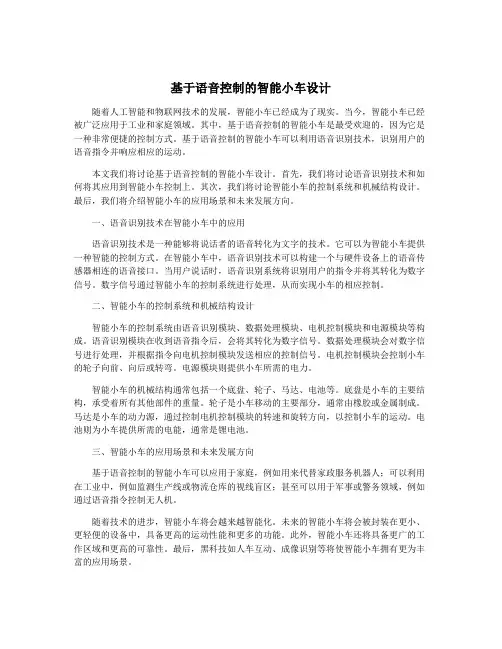
基于语音控制的智能小车设计随着人工智能和物联网技术的发展,智能小车已经成为了现实。
当今,智能小车已经被广泛应用于工业和家庭领域。
其中,基于语音控制的智能小车是最受欢迎的,因为它是一种非常便捷的控制方式。
基于语音控制的智能小车可以利用语音识别技术,识别用户的语音指令并响应相应的运动。
本文我们将讨论基于语音控制的智能小车设计。
首先,我们将讨论语音识别技术和如何将其应用到智能小车控制上。
其次,我们将讨论智能小车的控制系统和机械结构设计。
最后,我们将介绍智能小车的应用场景和未来发展方向。
一、语音识别技术在智能小车中的应用语音识别技术是一种能够将说话者的语音转化为文字的技术。
它可以为智能小车提供一种智能的控制方式。
在智能小车中,语音识别技术可以构建一个与硬件设备上的语音传感器相连的语音接口。
当用户说话时,语音识别系统将识别用户的指令并将其转化为数字信号。
数字信号通过智能小车的控制系统进行处理,从而实现小车的相应控制。
二、智能小车的控制系统和机械结构设计智能小车的控制系统由语音识别模块、数据处理模块、电机控制模块和电源模块等构成。
语音识别模块在收到语音指令后,会将其转化为数字信号。
数据处理模块会对数字信号进行处理,并根据指令向电机控制模块发送相应的控制信号。
电机控制模块会控制小车的轮子向前、向后或转弯。
电源模块则提供小车所需的电力。
智能小车的机械结构通常包括一个底盘、轮子、马达、电池等。
底盘是小车的主要结构,承受着所有其他部件的重量。
轮子是小车移动的主要部分,通常由橡胶或金属制成。
马达是小车的动力源,通过控制电机控制模块的转速和旋转方向,以控制小车的运动。
电池则为小车提供所需的电能,通常是锂电池。
三、智能小车的应用场景和未来发展方向基于语音控制的智能小车可以应用于家庭,例如用来代替家政服务机器人;可以利用在工业中,例如监测生产线或物流仓库的视线盲区;甚至可以用于军事或警务领域,例如通过语音指令控制无人机。
随着技术的进步,智能小车将会越来越智能化。
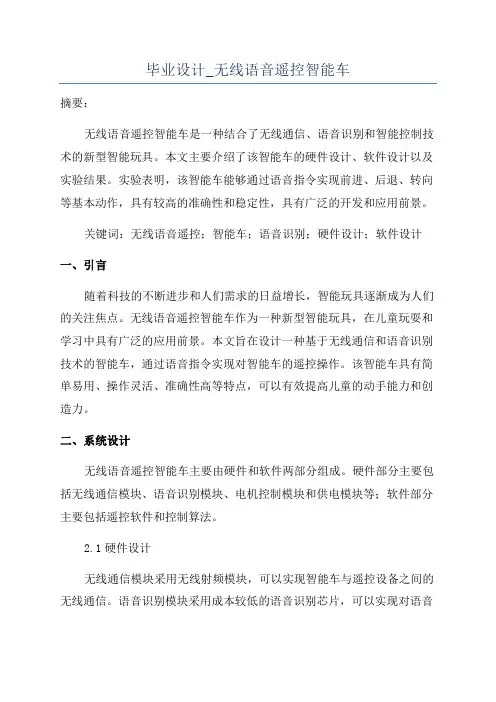
毕业设计_无线语音遥控智能车摘要:无线语音遥控智能车是一种结合了无线通信、语音识别和智能控制技术的新型智能玩具。
本文主要介绍了该智能车的硬件设计、软件设计以及实验结果。
实验表明,该智能车能够通过语音指令实现前进、后退、转向等基本动作,具有较高的准确性和稳定性,具有广泛的开发和应用前景。
关键词:无线语音遥控;智能车;语音识别;硬件设计;软件设计一、引言随着科技的不断进步和人们需求的日益增长,智能玩具逐渐成为人们的关注焦点。
无线语音遥控智能车作为一种新型智能玩具,在儿童玩耍和学习中具有广泛的应用前景。
本文旨在设计一种基于无线通信和语音识别技术的智能车,通过语音指令实现对智能车的遥控操作。
该智能车具有简单易用、操作灵活、准确性高等特点,可以有效提高儿童的动手能力和创造力。
二、系统设计无线语音遥控智能车主要由硬件和软件两部分组成。
硬件部分主要包括无线通信模块、语音识别模块、电机控制模块和供电模块等;软件部分主要包括遥控软件和控制算法。
2.1硬件设计无线通信模块采用无线射频模块,可以实现智能车与遥控设备之间的无线通信。
语音识别模块采用成本较低的语音识别芯片,可以实现对语音指令的准确识别。
电机控制模块采用电机驱动芯片,可以控制电机的转动方向和速度。
供电模块采用锂电池供电,可以提供稳定的电源。
2.2软件设计遥控软件采用Android平台进行开发,用户可以通过手机或平板电脑上的应用程序进行遥控操作。
控制算法主要包括语音识别算法和电机控制算法,通过对语音指令的解析和处理,实现对电机的控制。
三、实验结果通过对无线语音遥控智能车进行实验,验证了其可行性和有效性。
实验结果表明,该智能车能够准确识别语音指令,并能够按照指令进行相应动作,如前进、后退、转向等。
同时,该智能车的响应速度快、操作灵活,用户体验良好。
四、结论与展望本文设计了一种基于无线语音遥控的智能车,通过语音指令实现对智能车的遥控操作。
该智能车具有简单易用、操作灵活、准确性高等特点,可以作为一种智能玩具在儿童玩耍和学习中广泛应用。
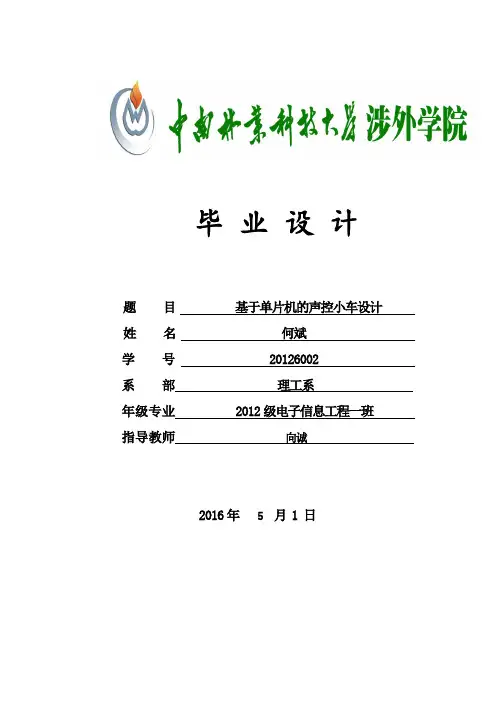
毕业设计题目基于单片机的声控小车设计姓名何斌学号 ********系部理工系年级专业2012级电子信息工程一班指导教师向诚2016年 5月 1 日摘要在过去三四十多年来,声控智能小车逐渐成为人们生活的必需品,声控智能小车为人们的居住、出行以及旅游等方面创造力良好的条件。
随着社会经济和科学技术的逐步发展,声控智能小车的设备也不断地进行更新换代,优秀的声控智能小车控制系统层出不穷。
另一方面,随着城市人口的剧增,声控智能小车面临需求量越来越大,传统的声控智能小车测量遥控时操作麻烦,精度不高。
声控智能小车使用者因为精度不高或者操作繁琐的情况时有发生,给声控智能小车声控智能小车使用者带来很多不便。
基于这种原因,现在声控智能小车急需增加在一定遥控范围内的功能系统,来解决声控智能小车面临的上述问题。
本文正是基于以上实际需求,设计了一种新型的基于单片机的声控智能小车控制器的设计系统。
该系统由89C51单片机作为系统控制芯片,在声控智能小车上增加USB电插口,并利用单片机控制在手机充满时自动关闭该口的电源;可以通过人体的声音识别来控制智能小车的前进或者拐弯等动作,可以用定量地控制用户对小车的控制。
关键词:声控智能小车;80C51;程序控制;遥控保护Title V oice control car design based on MCUAbstractIn the past thirty or forty years, the socket has gradually become a necessity in people's lives, outlet for people live, travel, tourism and other aspects of creativity in good condition. With the development of social economy and science and technology, socket equipment is constantly upgrading, excellent control system emerge in an endless stream socket. On the other hand, with the city's population increasing, facing socket demand is growing, the traditional temperature measurement socket operation trouble, the accuracy is not high. Because the socket user accuracy is not high or tedious situations have occurred, to bring a lot of inconvenience to users socket socket. For this reason, now need to increase the socket in a certain temperature range of the digital display system, to solve the problem faced by the socket.This paper is based on the actual demand, design a new design system of socket controller based on mcu. The system by the MCU 89C51 as the system control chip, USB power jack on the socket, and controlled by a single chip on the phone with automatically shut down the power; increase the anti lightning, anti short circuit, overload prevention, anti leakage function and power detection function, can use mobile phone client view this month's electricity.Key words: Socket; 80C51; program control; over current protection目录摘要 (II)1 绪论 (3)1.1 课题研究的背景和意义 (3)1.2 智能声控小车的设计原理 (4)1.3 设计的主要完成工作 (6)2 系统设计理论基础 (7)2.1 系统工作原理 (7)2.2 系统设计要求 (7)3 系统硬件设计 (9)3.1 单片机模块 (9)3.2 继电器模块 (11)3.3 液晶显示电路 (12)3.4 按键电路的设计 (13)3.5 语音识别电路设计 (14)3.6 电机驱动电路 (14)4 系统软件设计 (16)4.1 主程序流程 (16)4.2 语音识别模块编程 (17)4.3 LCD显示程序设计 (18)4.4 键盘接口应用实现 (20)4.5 系统遥控程序的实现 (21)5 系统仿真和调试 (22)5.1 PROTUES仿真软件的介绍 (22)5.2 KEIL软件的介绍 (23)5.3 系统仿真 (23)结论 (26)致谢 (27)参考文献 (28)附录(实物图与源代码) (29)1 绪论伴随着社会科技的发展和经济的进步,声控智能小车由上世纪八十年代的人工操作和遥控设定逐渐被自动控制加模块系统所替代。
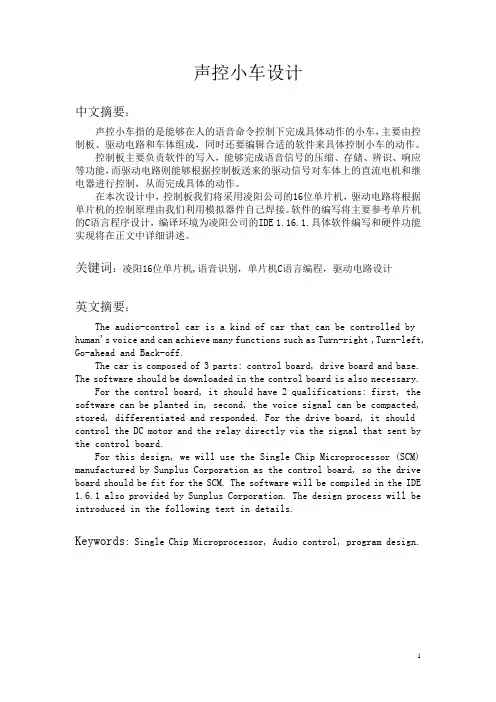
声控小车设计中文摘要:声控小车指的是能够在人的语音命令控制下完成具体动作的小车,主要由控制板、驱动电路和车体组成,同时还要编辑合适的软件来具体控制小车的动作。
控制板主要负责软件的写入,能够完成语音信号的压缩、存储、辨识、响应等功能,而驱动电路则能够根据控制板送来的驱动信号对车体上的直流电机和继电器进行控制,从而完成具体的动作。
在本次设计中,控制板我们将采用凌阳公司的16位单片机,驱动电路将根据单片机的控制原理由我们利用模拟器件自己焊接。
软件的编写将主要参考单片机的C语言程序设计,编译环境为凌阳公司的IDE 1.16.1.具体软件编写和硬件功能实现将在正文中详细讲述。
关键词:凌阳16位单片机,语音识别,单片机C语言编程,驱动电路设计英文摘要:The audio-control car is a kind of car that can be controlled by human's voice and can achieve many functions such as Turn-right ,Turn-left, Go-ahead and Back-off.The car is composed of 3 parts: control board, drive board and base. The software should be downloaded in the control board is also necessary. For the control board, it should have 2 qualifications: first, the software can be planted in, second, the voice signal can be compacted, stored, differentiated and responded. For the drive board, it should control the DC motor and the relay directly via the signal that sent by the control board.For this design, we will use the Single Chip Microprocessor (SCM) manufactured by Sunplus Corporation as the control board, so the drive board should be fit for the SCM. The software will be compiled in the IDE 1.6.1 also provided by Sunplus Corporation. The design process will be introduced in the following text in details.Keywords: Single Chip Microprocessor, Audio control, program design.目录:前言 (3)一、硬件电路设计及连接 (3)1.1 SPCE061A (3)1.1.1 SPCE061A总述 (3)1.1.2SPCE061A 性能 (3)1.1.3 选择SPCE061A的理由 (4)1.1.4 凌阳16位单片机SPCE061A实物图 (4)1.1.5 SPCE061A内部结构框图 (5)1.2.车体驱动电路 (6)1.2.1车体驱动电路设计思路 (6)1.2.2实际驱动电路 (7)1.3、小车车底部分 (8)1.4.硬件部分结论 (8)二、软件编写与调试 (9)2.1主程序流程图 (9)2.2 控制口连接方式 (10)2.3.RAM中数据存取方式 (11)2.4语音训练和识别 (12)2.4.1语音命令训练过程 (12)2.4.2语音识别过程 (13)2.5 具体动作的实现 (13)2.6语音命令的重新训练 (14)2.7程序的组成和调试 (14)2.8程序代码下载 (15)三、小车的操作说明: (15)3.1使用方法 (15)3.2使用时的注意事项 (15)四、结论 (16)五、参考书目 (16)正文:前言:本次设计的目的是利用凌阳16位单片机SPCE061A的语音播放和语音识别资源进行语音控制,使小车能在具体的语音命令下完成前进、后退、左拐、右拐的动作。
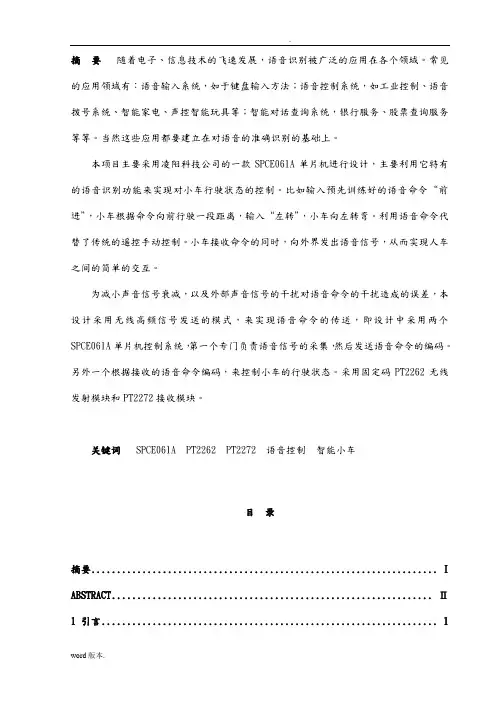
摘要随着电子、信息技术的飞速发展,语音识别被广泛的应用在各个领域。
常见的应用领域有:语音输入系统,如于键盘输入方法;语音控制系统,如工业控制、语音拨号系统、智能家电、声控智能玩具等;智能对话查询系统,银行服务、股票查询服务等等。
当然这些应用都要建立在对语音的准确识别的基础上。
本项目主要采用凌阳科技公司的一款SPCE061A单片机进行设计,主要利用它特有的语音识别功能来实现对小车行驶状态的控制。
比如输入预先训练好的语音命令“前进”,小车根据命令向前行驶一段距离,输入“左转”,小车向左转弯。
利用语音命令代替了传统的遥控手动控制。
小车接收命令的同时,向外界发出语音信号,从而实现人车之间的简单的交互。
为减小声音信号衰减,以及外部声音信号的干扰对语音命令的干扰造成的误差,本设计采用无线高频信号发送的模式,来实现语音命令的传送,即设计中采用两个SPCE061A单片机控制系统,第一个专门负责语音信号的采集,然后发送语音命令的编码。
另外一个根据接收的语音命令编码,来控制小车的行驶状态。
采用固定码PT2262无线发射模块和PT2272接收模块。
关键词SPCE061A PT2262 PT2272 语音控制智能小车目录摘要 (I)ABSTRACT (Ⅱ)1 引言 (1)2 背景介绍 (1)2.1 选题背景 (1)2.2 研究的目的及意义 (2)3 设计要求 (2)3.1系统功能 (2)3.2基本参数 (2)4 方案论证 (2)4.1 方案一 (2)4.2 方案二 (3)4.3 方案三 (3)4.4 方案比较 (4)5 系统硬件设计 (4)5.1系统总体方案介绍 (4)5.2SPCE061A单片机 (5)5.3SPCE061A最小系统 (6)5.4电源 (7)5.5无线发射接收模块PT2262PT2272 (8)5.6小车控制板 (9)5.7小车车体架构 (12)5.8SPCE061A精简开发板 (13)5.9系统实物图 (13)6 系统软件设计 (15)6.1软件结构 (15)6.2语音识别原理简介 (16)6.3训练子程序 (17)6.4语音识别子程序 (18)6.5动作子程序 (19)6.6中断子程序 (20)7 操作步骤 (21)7.1硬件连接 (21)7.2代码下载 (21)8 测试 (21)9 结论 (22)参考文献 (22)致 (23)附录 (24)基于SPCE061A单片机的语音遥控小车的设计1引言随着电子、信息技术的飞速发展,语音识别被广泛的应用在各个领域。
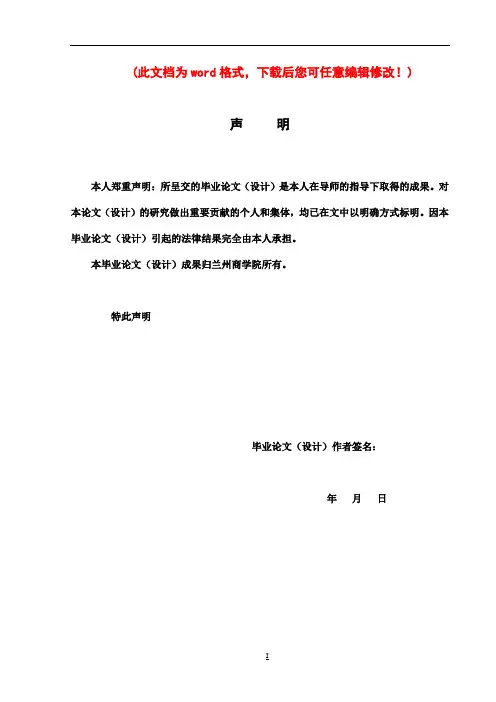
(此文档为word格式,下载后您可任意编辑修改!)声明本人郑重声明:所呈交的毕业论文(设计)是本人在导师的指导下取得的成果。
对本论文(设计)的研究做出重要贡献的个人和集体,均已在文中以明确方式标明。
因本毕业论文(设计)引起的法律结果完全由本人承担。
本毕业论文(设计)成果归兰州商学院所有。
特此声明毕业论文(设计)作者签名:年月日语音识别智能小车摘要本文介绍一款语音识别智能小车的设计。
该小车以SPCE061A为控制核心,可通过语音识别对其行驶状态和控制模式进行控制和切换。
本设计主要完成了各部分硬件模块的设计,同时实现了智能小车的语音识别、语音播放、模式切换、行驶状态控制、无线遥控等功能的软件设计,从而使小车和控制者具有一定的交互功能。
测试表明,小车可以根据控制者的操作做出相应的动作。
[关键词] SPCE061A语音识别无线遥控交互功能ABSTRACTThis paper introduces speech recognition of intelligent car design. The car to SPCE061A as control core, what but through the speech recognition on the operation and control model control and switch. This design main completed each part of the design of the , speech broadcast, mode switch, driving state control, wireless remote control functions of software design, so as to make the car and the controllers interactive function. Tests show that, according to the operation of the car can controller make corresponding action. [Key Words] SPCE061A, Voice control, Wireless module, Interactive function目录一、引言 (1)二、概述和方案论证 (2)(一)控制核心的选择及其简介 (3)(二)小车车体的方案选择 (4)(三)无线接收电路模块和遥控器及简介 (5)(四)避障模块 (5)三、硬件设计 (6)(一)系统电源电路 (6)(二)语音识别电路 (7)(三)语音播放电路 (7)(四)壁障电路 (8)(五)小车车体与驱动电路 (8)1、小车车体结构 (8)2、电机驱动电路 (9)(六)小车总体硬件实物图 (11)(七)PCB的设计 (11)四、软件设计 (12)(一)主程序设计 (12)(二)语音播放子程序设计 (13)五、测试和说明 (15)(一)说明 (15)1、端口定义 (15)2、操作说明 (15)3、命令简介 (15)4、注意事项 (16)(二)测试 (16)六、结论 (16)参考文献 (18)致谢 (19)附录 (20)语音识别智能小车一、引言随着科学技术的发展,电子产品日新月异,自动语音识别技术[8, 10]的应用真正走入了人们的日常生活,声控系统的应用也不再遥不可及,家用电器和玩具的操作,不再需要以遥控器的繁多按键为控制接口,取而代之的是我们平常说话的模式来驱使家用电器和玩具动作,诸如多种智能电器、玩具小车。
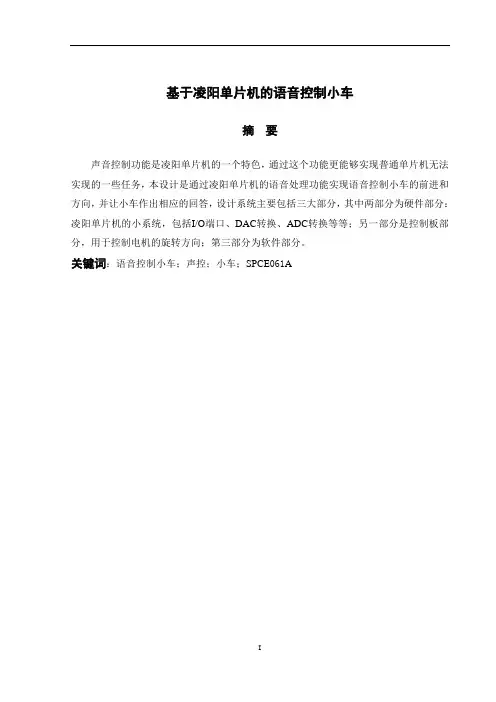
基于凌阳单片机的语音控制小车摘要声音控制功能是凌阳单片机的一个特色,通过这个功能更能够实现普通单片机无法实现的一些任务,本设计是通过凌阳单片机的语音处理功能实现语音控制小车的前进和方向,并让小车作出相应的回答,设计系统主要包括三大部分,其中两部分为硬件部分:凌阳单片机的小系统,包括I/O端口、DAC转换、ADC转换等等;另一部分是控制板部分,用于控制电机的旋转方向;第三部分为软件部分。
关键词:语音控制小车;声控;小车;SPCE061ABased on Ling Y ang monolithic integrated circuit's voice control carAbstractThe phonic control function is a Ling Y ang monolithic integrated circuit's characteristic, suffices some duties which through this function realizes the ordinary monolithic integrated circuit to be unable to realize, this design is realizes the voice control car's advance and the direction through the Ling Y ang monolithic integrated circuit's pronunciation processing function, and lets the car make the corresponding reply, the design system mainly includes three major parts, two parts for hardware part: The Ling Y ang monolithic integrated circuit's small system, including the I/O port, DAC transforms, ADC transformation and so on; Another part is the control panel part, uses in controlling electrical machinery's hand of rotation; The third part is the software part.Key word: V oice control car;V oice control;Car;SPC061A目录1 引言 (1)2方案论证 (2)2.1方案论证 (2)3语音控制小车设计要求 (3)3.1功能要求 (3)3.2备注 (3)3.2.1 参数说明 (3)3.2.2 注意事项 (3)3.3扩展功能 (3)4 凌阳芯片的介绍 (4)4.1SPCE061A芯片的特点及其功能 (4)4.2SPCE061A芯片内核结构 (5)5硬件系统设计 (6)5.1系统的总体方案 (6)5.1.1 16位微处理器芯片的外围结构 (6)5.261板的各部分硬件模块 (7)5.2.1 麦克录音输入及AGC电路 (7)5.2.2 数摸转换电路 (7)5.2.3 按键,LED和复位电路 (8)5.2.4 电源电路 (8)5.2.5 下载线接口电路和在线调制电路 (9)5.2.6 16位微处理器的连接电路 (9)5.3车体介绍 (10)5.4小车的行走原理 (10)5.5控制电路原理板 (11)5.6控制电路原理 (12)5.6.1 后轮电机驱动电路原理 (12)5.6.2 前轮电机驱动电路原理 (13)6 系统软件设计 (14)6.1系统主程序设计流程图 (14)6.2语音识别 (15)7硬件制作及系统调试 (17)7.1硬件制作 (17)7.2调试和下载程序 (17)7.3调试小车 (17)7.4初试小车 (17)7.5重新调试 (18)结束语 (19)致谢 (20)参考文献 (21)附录附录1 电路原理图(61板)附录2 电路原理图(控制板)附录3 元件清单附录4 PCB图附录5 小车图片附录6 主控制源程序基于凌阳单片机的语音控制小车1 引言语音控制技术是一门新兴技术,可以通过语音直接控制电子产品,摆脱了遥控器的束缚。
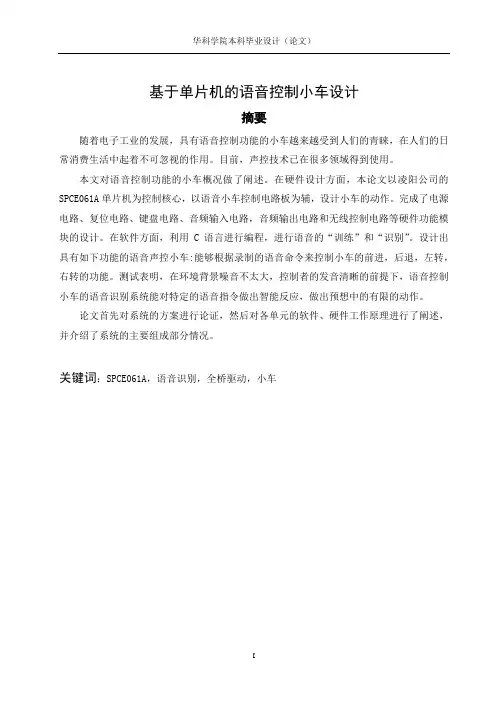
基于单片机的语音控制小车设计摘要随着电子工业的发展,具有语音控制功能的小车越来越受到人们的青睐,在人们的日常消费生活中起着不可忽视的作用。
目前,声控技术已在很多领域得到使用。
本文对语音控制功能的小车概况做了阐述。
在硬件设计方面,本论文以凌阳公司的SPCE061A单片机为控制核心,以语音小车控制电路板为辅,设计小车的动作。
完成了电源电路、复位电路、键盘电路、音频输入电路,音频输出电路和无线控制电路等硬件功能模块的设计。
在软件方面,利用C语言进行编程,进行语音的“训练”和“识别”。
设计出具有如下功能的语音声控小车:能够根据录制的语音命令来控制小车的前进,后退,左转,右转的功能。
测试表明,在环境背景噪音不太大,控制者的发音清晰的前提下,语音控制小车的语音识别系统能对特定的语音指令做出智能反应,做出预想中的有限的动作。
论文首先对系统的方案进行论证,然后对各单元的软件、硬件工作原理进行了阐述,并介绍了系统的主要组成部分情况。
关键词:SPCE061A,语音识别,全桥驱动,小车IVoice control car design based on single chipmicrocomputerAbstractWith the development of the electronics industry, the voice - the control car become more and more popular to people. And it plays an important role in people 's daily life. At present, the voice - activated technology has had 2 in many fields, For example, voice - activated phone. Only if you called out the names you want and it automatically called to the telephone.This article gives a detail to the voice-activated car. In hardware design, the paper use Sunplus SPCE061A as the control of core. On the software, we use C language programming for voice "training"and"recognition". .Completedthepowercircuit,resetcircuit,keyboardcircuitry,audioinput circuits,audiooutputcircuitandcontrolcircuitofwirelesshardwaresuchasthedesignoffunctionmodule s.It has the following features: According to recorded the voice command to control the car to start, stop,turn right , and turn left. Tests have shown that background noise in the environment is not too big, the controller under the premise of clear pronunciation, voice control car voice recognition system can make intelligent response to a particular voice commands, limited, as expected.First of all, cca shut confirm the system of the program, and then describe the unit 's software and hardware as well as introduce the main components of the situation.Key words:S PCE061A,Speech Recognition,Full-bridge ,driver,TrolleyII目录摘要 (I)Abstract (II)第1章绪论.......................................................................................................................... - 1 -1.1 选题的目的和意义.................................................................................................... - 1 -1.1.1选题目的............................................................................................................. - 1 -1.1.2.选题意义............................................................................................................. - 1 -1.2 语音小车的发展及现状............................................................................................ - 1 -1.3 课题的目的任务和要求............................................................................................ - 2 - 第2章语音小车的方案论证.................................................................................................. - 3 -2.1 语音控制方案............................................................................................................ - 3 -2.2 方案论证.................................................................................................................... - 4 -2.2.1 采用DSP+FPGA方案 ...................................................................................... - 4 -2.2.2采用MCS-51方案 ............................................................................................. - 4 -2.2.3 采用凌阳61方案.............................................................................................. - 5 -2.3 系统控制方案............................................................................................................ - 6 - 第3章系统硬件设计.............................................................................................................. - 9 -3.1 系统硬件总体设计.................................................................................................... - 9 -3.2 系统各单元设计...................................................................................................... - 10 -3.2.1 控制单元设计.............................................................................................. - 10 -3.2.2 动力单元设计.............................................................................................. - 15 -3.2.3 音频单元设计.............................................................................................. - 16 -3.2.4 小车单元设计.............................................................................................. - 19 -3.3 系统总体电路图...................................................................................................... - 26 - 第4章系统软件设计............................................................................................................ - 27 -4.1系统总体程序设计................................................................................................. - 27 -4.2 系统各分支设计..................................................................................................... - 28 -4.2.1训练子程序....................................................................................................... - 28 -4.2.2语音识别子程序............................................................................................... - 29 -I I I4.2.3动作子程序....................................................................................................... - 31 -4.2.4中断子程序....................................................................................................... - 34 - 第5章系统调试.................................................................................................................... - 37 -5.1 硬件调试.................................................................................................................. - 37 -5.2 软件调试.................................................................................................................. - 38 -5.3 系统联调.................................................................................................................. - 39 - 结论........................................................................................................................................ - 41 - 参考文献.................................................................................................................................. - 43 - 致谢........................................................................................................................................ - 45 - 附录........................................................................................................................................ - 47 -I V第1章绪论1.1 选题的目的和意义1.1.1选题目的通过设计一个用单片机控制的语音小车来熟悉模块化编程方法,掌握C语言汇编语言的程序设计和调试方法,并理解单片机的原理、结构、指令;运行模式及应用方法。
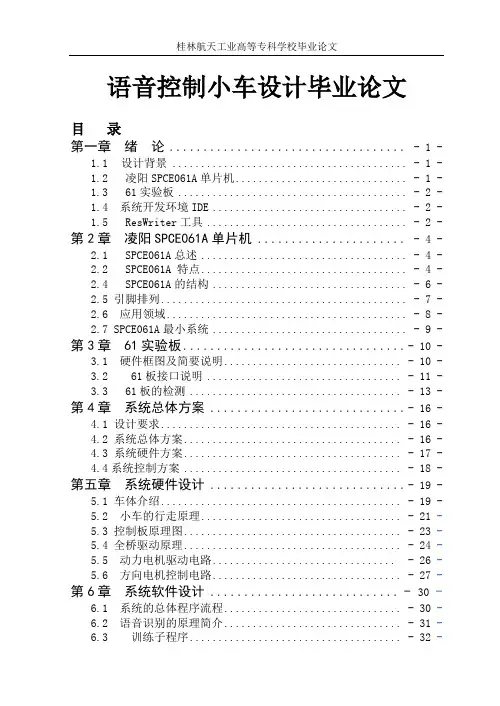
语音控制小车设计毕业论文目录第一章绪论................................... - 1 -1.1设计背景 ......................................... - 1 -1.2 凌阳SPCE061A单片机.............................. - 1 -1.3 61实验板........................................ - 2 -1.4 系统开发环境IDE .................................. - 2 -1.5 ResWriter工具................................... - 2 - 第2章凌阳SPCE061A单片机 ...................... - 4 -2.1 SPCE061A总述.................................... - 4 -2.2 SPCE061A 特点.................................... - 4 -2.4 SPCE061A的结构.................................. - 6 -2.5 引脚排列........................................... - 7 -2.6 应用领域.......................................... - 8 -2.7 SPCE061A最小系统.................................. - 9 -第3章 61实验板................................. - 10 -3.1 硬件框图及简要说明............................... - 10 -3.2 61板接口说明.................................. - 11 -3.3 61板的检测..................................... - 13 -第4章系统总体方案 ............................. - 16 -4.1 设计要求.......................................... - 16 -4.2 系统总体方案...................................... - 16 -4.3 系统硬件方案...................................... - 17 -4.4系统控制方案...................................... - 18 -第五章系统硬件设计 ............................. - 19 -5.1 车体介绍.......................................... - 19 -5.2 小车的行走原理................................... - 21 -5.3 控制板原理图...................................... - 23 -5.4 全桥驱动原理...................................... - 24 -5.5 动力电机驱动电路................................ - 26 -5.6 方向电机控制电路................................. - 27 -第6章系统软件设计 ............................ - 30 -6.1 系统的总体程序流程............................... - 30 -6.2 语音识别的原理简介............................... - 31 -6.3 训练子程序..................................... - 32 -6.4 语音识别子程序................................. - 34 -6.5 动作子程序...................................... - 34 -6.6 中断子程序...................................... - 36 -6.7 程序中需要说明的几个问题......................... - 37 - 第7章系统开发环境 ............................ - 39 - 第8章语音小车的使用 .......................... - 40 -8.1 连接硬件......................................... - 40 -8.2 代码下载......................................... - 40 -8.3 训练小车......................................... - 41 -8.4 声控小车......................................... - 42 -8.5 重新训练......................................... - 43 - 结语........................................ - 44 - 致谢........................................ - 45 - 参考文献........................................ - 46 - 附录一:语音控制小车源代码 .................... - 47 -第一章绪论1.1设计背景语音处理技术是一门新兴的技术,它不仅包括语音的录制和播放,还涉及语音的压缩编码和解码,语音的识别等各种处理技术。
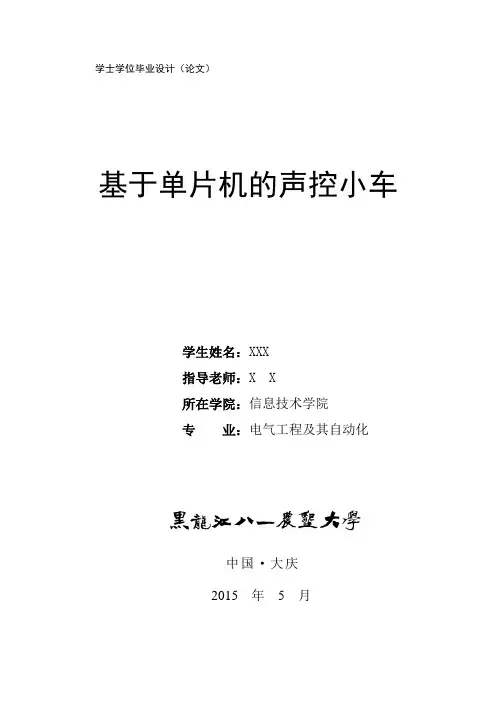
学士学位毕业设计(论文)基于单片机的声控小车学生姓名:XXX指导老师:X X所在学院:信息技术学院专业:电气工程及其自动化中国·大庆2015 年 5 月摘要本文主要设计一种用语音进行控制的单片机小车。
声控小车以拥有可编程音频处理的凌阳SPCE061A单片机作为整个系统的控制核心,不需要添加额外的语音芯片就能实现语音控制功能;声控小车采用H桥电路控制小车电机转动,根据语音识别技术,采用C语言进行编程,实现小车的前进、停止左转和右转,以及语音播报功能。
关键词:SPCE061A 声控小车语音识别H桥电路ABSTRACTThis paper states the design of a voice control car based on single chip microcomputer. In hardware design of the car, we use SPCE061A as the control center in the system, which have programmable audio processing and can realize voice control function without additional voice chip. V oice control car use H- bridge circuit to control the car motor rotation, according to the speech recognition technology, using C language programming, realize the car forward, stop, turn left, turn right and voice broadcast.Keywords: SPCE061A V oice control car Speech recognition technology H- bridge circuit目录摘要 (I)ABSTRACT ........................................................................................ I I 前言 (IV)1绪论.............................................................................................. - 1 -1.1国内外研究发展和现状 ........................................................ - 1 - 1.2研究主要内容......................................................................... - 2 -1.3研究的目的和意义................................................................. - 3 -2 小车的设计方案......................................................................... - 4 -2.1设计方案的选择..................................................................... - 4 -2.2整体设计方案......................................................................... - 4 -3 系统的硬件设计......................................................................... - 7 -3.1 MCU核心控制模块设计 ...................................................... - 7 - 3.2语音识别模块的设计........................................................... - 10 - 3.3 电机及其驱动电路模块设计 ............................................. - 13 -3.4电源模块............................................................................... - 15 -4 系统的软件设计....................................................................... - 17 -4.1语音模块程序设计............................................................... - 18 - 4.2电机控制模块程序设计 ...................................................... - 19 - 4.3主程序设计........................................................................... - 20 - 结论............................................................................................... - 22 -参考文献....................................................................................... - 23 -致谢............................................................................................... - 25 -附录一声控小车硬件原理图 .................................................... - 26 -附录二声控小车程序................................................................. - 27 -前言随着人们生活水平的提高,电子产品的快速发展,普通电子产品的消费已经满足人们需求。
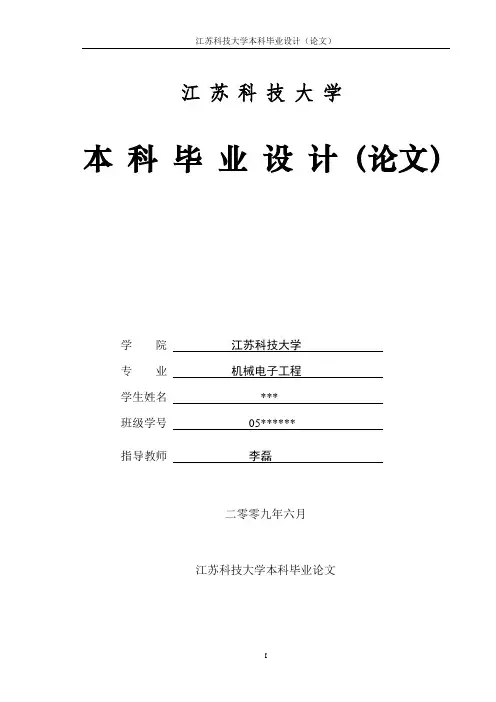
江苏科技大学本科毕业设计(论文)学院江苏科技大学专业机械电子工程学生姓名***班级学号05******指导教师李磊二零零九年六月江苏科技大学本科毕业论文江苏科技大学本科毕业论文基于单片机的声控小车控制The control of V oice-activated car based on Single Chip摘要随着电子工业的发展,具有语音控制功能的小车越来越受到人们的青睐,在人们的日常消费生活中起着不可忽视的作用。
目前,声控技术已在很多领域得到使用。
比如声控手机、声控洗衣机、电视机、电脑等设备。
本文对声控小车概况做了阐述。
在硬件设计方面,本论文以凌阳公司的SPCE061A 单片机为控制核心,以语音小车控制电路板为辅,设计小车的动作。
在软件方面,利用C语言进行编程,进行语音的“训练”和“识别”。
设计出具有如下功能的语音声控小车:能够根据录制的语音命令来控制小车的启动、停止、返回、拐弯。
论文首先对系统的方案进行论证,然后对各单元的软件、硬件工作原理进行了阐述,并介绍了系统的主要组成部分情况。
关键词:SPCE061A,语音识别,全桥驱动,小车AbstractWith the development of the electronics industry,the voice-control car become more and more popular to people. And it plays an important role in people's daily life. At present, the voice-activated technology has been used in many fields. For example, voice-activated phone. Only if you called out the names you want and it automatically called the telephone. There are also voice-activated washing machines, televisions, computers and other equipments.This article gives a detail to the voice-activated car. In hardware design, the paper use Sunplus SPCE061A as the control of core. On the software, we use C language programming for voice "training" and "recognition". It has the following features: According to recorded the voice command to control the car to start, stop, return, and turn.First of all ,papers confirm the system of program, and then describe the unit's software, hardware as well as introduce the main components of the situation.Key words: SPCE061A,Speech Recognition,Full-bridge driver,Trolley目录第一章绪论 (1)1.1引言 (1)1.2国内外研究状况 (1)1.3存在的不足或有待解决的问题 (2)1.4课题的目的任务和要求 (2)第二章设计方案论证 (3)2.1系统总体方案 (3)2.2系统硬件方案 (4)2.3系统控制方案 (5)2.4小结 (5)第三章系统硬件设计 (6)3.1SPCE061A 特性简介 (6)3.2精简开发板——61 板 (7)3.3车体介绍 (8)3.3.1小车的行走原理 (9)3.4控制板原理图 (11)3.4.1全桥驱动原理 (12)3.4.2动力电机驱动电路 (15)3.4.3方向电机控制电路 (15)3.5小结 (17)第四章系统软件设计 (18)4.1 系统的总体程序流程 (18)4.1.1 语音识别的原理简介 (19)4.1.2 训练子程序 (20)4.1.3 语音识别子程序 (22)4.1.4 动作子程序 (22)4.1.5 中断子程序 (24)4.2 程序中需要说明的几个问题 (25)4.3小结 (26)结语 (27)致谢 (28)参考文献 (29)附录 (31)第一章绪论1.1引言所谓声控技术其实也就是利用语音识别技术来达到控制或者操作的一种技术,而语音识别技术这近五年来已经有很大的进步,最新的语音识别技术可以辨识90%以上的人类说出的字。
本科毕业设计(论文)基于语音控制的智能小车设计学生学院信息工程学院专业测控技术与仪器(光机电一体化方向)年级班别20 级(1)班学号学生姓名指导教师20 年月摘要现代社会电子产业高速发展使自动化成为广大民众的日常话题,越来越普及的语音控制系统在生活中随处可见,随着时间的推移,自动化与语音控制系统的结合也必将进入商用阶段。
本文将设计一种通过无线语音控制系统模拟的未来智能语音小车,展示智能语音小车的软件、硬件设计原理。
智能语音小车使用凌阳公司推出的SPCE061A 16位单片机作为主控中心,其中不仅拥有完整的系统电路,另外包含了供电、声音和复位电路等,配合其语音播放以及语音识别的特色,通过训练的语音指令命令小车使其前进、倒退、左转、右转,另外小车还支持重新语音训练。
SPCE061A 16位单片机具有低电压、低功耗、高性价比等特点,配合其开发环境IDE即可完成小车的总体设计方案,其中包含了语音播放、语音识别、驱动等,最终成为一辆智能的语音控制小车。
该系统是以特定人嵌入式语音识别系统为主。
通过实验测试表明,在外界的环境噪音较小并且发令者发音清晰的情况下,该小车可以对经过训练后的语音指令做出动作,并且性能稳定。
最后将会介绍IDE集成开发环境的功能,开发操作方法,以及如何使用小车。
该设计在软硬件的角度具有前瞻性,具体说明了未来智能语音小车的发展方向,具有推广价值。
关键词:SPCE061A,无线语音控制,语音识别,单片机,智能小车AbstractModern society The rapid development of the electronics industry makes automation become the daily topic of the general public. The increasingly popular voice control system can be seen everywhere in life. With the passage of time, the combination of automation and voice control system will enter the commercial stage.This article will introduce a wireless voice control system simulation of the future of intelligent voice car, display intelligent voice car software, hardware design principles. Intelligent voice car using Sunplus SPCE061A 16-bit microcontroller as the main control center, which not only has a complete system circuit, including the power supply, sound and reset circuit, with its voice playback and voice recognition features, through training V oice command command car to make it forward, back, turn left, turn right, another car also supports re-voice training. SPCE061A 16-bit microcontroller with low voltage, low power consumption, cost-effective features, with its development environment IDE can complete the overall design of the car, which includes voice playback, voice recognition, drive, etc., and ultimately become a smart voice Control the car. Experiments show that the car can be trained on the voice commands after training, and the performance is stable when the ambient noise is small and the sender is clear. The design of the hardware and software in the perspective of a forward-looking, specifically the future direction of the development of intelligent voice car, with the promotion of value.Key words:SPCE061A,Wireless voice control,Speech Recognition,Single chip,Smart car目录1 绪论 (1)1.1 题目背景及目的 (1)1.2 国内外研究状况 (1)1.3 题目研究内容 (2)2 语音识别小车的硬件总体方案 (3)2.1 设计要求 (3)2.2 SPCE061A总述 (3)2.2.1 SPCE061A特点 (3)2.2.2 SPCE061A性能 (4)2.2.3 SPCE061A的结构 (4)2.2.4 引脚排列 (5)2.3 SPCE061A最小系统 (6)2.4 61板硬件框图及简要说明 (7)2.4.1 61板接口说明 (8)2.4.2 61板的检测 (10)2.5 系统总体方案 (12)2.5.1 系统硬件方案 (13)2.5.2 系统控制方案 (14)2.6 车体部分介绍 (14)2.7 小车的行走原理 (15)2.8 控制板原理图 (15)2.9 全桥驱动原理 (16)2.9.1 动力驱动电路 (17)2.9.2 方向控制电路 (18)3 语音识别系统的软件设计 (20)3.1 语音识别系统 (20)3.2 语音识别系统的硬件组成 (20)3.3 语音信号的预处理 (21)3.4 特征参数提取 (21)3.5 矢量量化技术 (22)3.6 模板训练方法及匹配方法 (22)3.7 系统软件总体程序流程 (22)3.8 语音识别的层次结构及流程 (24)3.8.1 训练子程序 (25)3.8.2 语音识别子程序 (26)3.8.3 动作子程序 (27)3.8.4 中断子程序 (29)3.8.5 系统开发环境IDE及ISP工具 (29)3.9 程序中需要说明的问题 (30)4 智能语音小车的测试 (32)4.1 连接硬件 (32)4.2 代码下载 (32)4.3 训练小车 (33)4.4 声控小车 (34)4.5 重新训练 (34)4.6 语音识别测试结果 (35)结论 (36)参考文献 (37)致谢 (38)附录A (39)1 绪论1.1 题目背景及目的现代社会电子技术发展迅猛,自动化也随之崛起,在语音识别已成为大众日常生活中的一部分时,预见未来的汽车也将发展成为音控驾驶。
TP3黄常明2010年月日摘要摘要随着科学技术和人类生活水平的提高,利用语音识别技术来设计、制造各种消费电子产品和电器设备,是社会发展的必然趋势。
什麽是语音识别技术呢!简单地说,就是电子设备或计算机设备能听懂人说的话,并理解它,做出正确的反映,或者去实施相应的动作,它是融合了多门学科的一个研究领域。
语音识别技术具有非常大的发展前景,本文全面地总结了该领域的发展历史,阐述了本课题的社会意义和经济价值。
课题首先全面剖析了语言、语音的基本特性,分析了语音识别系统的算法建模的理论基础,以及如何构成ASR技术系统的基本结构,并详细说明了该系统的工作原理。
由理论基础和识别技术上的研究可知,语音识别系统主要分为两大类:一类是以研究生产的专门芯片为硬件的核心,构成嵌入式语音识别系统;另一类是以PC机为核心硬件构成较大型的语音识别系统。
根据SPCE061A单片机独特的嵌入式语音识别系统和相应的集成开发环境,本课题设计出了基于语音控制的电动小车,该系统是以特定人嵌入式语音识别系统为主,也可适应于非特定人的语音识别系统。
设计了小车的实体构成系统及相应的组装、检测过程,并编写了相应的系统软件程序,该小车能够在语音的控制下,自如地实现前进、后退、转向、停止等各种运动状态。
本系统在语音音频特性的取样过程中,我们的数据必须通过很好的压缩处理来节约空间,应用了失量量化的方式进行,主要采用了离散隐马尔可夫模型和其他的相应算法来实现语音模板的训练,同时实现相应的识别命令。
最后,详细地介绍了IDE集成开发环境的功能,开发操作方法,以及如何进行程序的加载和调试。
关键词:语音识别,系统原理,语音控制,电动小车IABSTRACTAs science and technology and human living standards, the use of voice recognition technology to design and manufacture a variety of consumer electronic products and electrical equipment, is the inevitable trend of social development. What is speech recognition technology does! Simply put, that is, electronic devices or computer equipment can understand people saying, and understand it, and make a correct reflection of, or to implement the corresponding action, which is the integration of a multi-discipline field of study.Speech recognition technology has great prospects for development, this article summarizes a comprehensive history of the development in this area, explained the topic of social significance and economic value. First, a comprehensive analysis of issues of language, voice, basic characteristics, analysis of the speech recognition system modeling algorithm theoretical basis, and how to constitute the basic structure of ASR technology systems, and details of the system works.By the theoretical foundation and identify the technical research we can see that voice recognition system is mainly divided into two categories: one is based on research and production of specialized chips for the hardware, the core, constitutes an embedded speech recognition system; and those based on PC, as the the core hardware structure of the larger speech recognition system.According to SPCE061A SCM's unique embedded speech recognition system and the corresponding integrated development environment, this topic based on voice control design of electric trolley, the system is based on a particular person based embedded speech recognition system can also be adapted to non-specific human voice recognition system. Designed a trolley system and the corresponding entities constitute the assembly, testing process and the preparation of the corresponding system software program, the car can be under the control of speech, the freedom to achieve forward, backward, turn, stop, and other state of motion. This system features the voice audio sampling process, our data must pass a very good compression to save space, the application of the loss of a way to quantify the amount of the main uses of discrete hidden Markov models and other algorithms to achieve the corresponding voiceIItemplate of training, while achieving the corresponding recognize the command. Finally, the detailed description of the function of IDE integrated development environment to develop operational methods, and how to load and debug programsAt present, speech recognition system to sb-core hardware, mainly to PC machine as the core hardware and the speech recognition system to a dedicated hardware chip as the core of the embedded speech recognition system. In this paper, the stdy is based on SCM SPCEO61A people and non-specific embedded speech recognition system.Key words:speech recognition, systems theory, voice control, SPCE061A single-chip, small electricalIII电子科技大学硕士学位论文目录第一章绪论 (1)1.1 课题研究的意义及背景 (1)1.2 国内外研究发展概况与趋势 (2)1.3 嵌入式系统及其发展历程 (2)1.4 本课题研究内容与论文结构 (3)第二章语音识别基础 (5)2.1 语音识别的声学基础 (5)2.1.1 建立语音信号数学模型的意义 (5)2.1.2 语音信号产生的数学模型 (5)2.1.3 汉语音节的结构和特点 (6)2.2 语音识别的系统结构 (7)2.2.1 语音通信的层次模型 (7)2.2.2 语音识别的原理 (9)2.3 传统语音识别系统的不足 (9)第三章语音识别系统的基本原理 (11)3.1 语音识别系统的结构原理 (11)3.2 语音识别系统的硬件组成 (11)3.3 语音信号的预处理 (12)3.3.1 语音采样 (12)3.3.2 去除噪音 (13)3.3.3 端点检测的方法 (14)3.3.4 预加重 (14)3.3.5 加窗分帧 (15)3.4 特征参数提取 (15)3.4.1 线性预测系数 (16)3.4.2 线性预测倒谱系数 (17)IV目录3.4.3 Mel倒谱系数(MFCC (18)3.5 矢量量化技术 (19)3.6 模板训练方法 (20)3.7 模板匹配方法 (20)3.7.1 隐马尔可夫模型 (20)3.7.2 动态时间归整 (23)3.7.3 人工神经网络 (23)第四章基于语音控制的电动小车的总体设计 (24)4.1 系统的组成设计 (24)4.1.1 语音控制电动小车的硬件组成框图 (24)4.1.2 系统总体硬件组成设计说明 (24)4.2 主控模块的电路设计 (25)4.2.1 SPCE061A的结构图 (25)4.2.2 SPCE061A的性能 (25)4.3 微处理及语音识别部分电路 (26)4.3.1 16位算术逻辑运算 (26)4.3.2 结合算术逻辑的16位移位运算 (27)4.3.3 DSP处理与语音识别 (27)4.4 接口与驱动部分电路的设计 (27)4.4.1 电源电路 (27)4.4.2电机接口电路 (28)4.4.3 电机驱动电路 (29)4.4.4 ICE接口电路 (30)4.5 主控板组装与测试 (30)4.5.1主控板及元器件 (30)4.5.2 电路板组装步骤 (33)4.5.3 主控板测试 (35)4.6 电动小车的设计 (37)第五章语音识别系统的软件设计 (39)5.1 软件总体的设计 (39)5.1.1 设计思想和流程图 (39)V电子科技大学硕士学位论文5.1.2 程序代码 (40)5.2 语音训练模块的设计 (44)5.2.1 设计思想和流程图 (44)5.2.2 程序代码 (45)5.3 语音识别模块的设计 (48)5.4 动作控制模块的设计 (49)5.5 定时中断程序的设计 (52)第六章系统的开发环境及调测结果 (54)6.1 u'nSP TM IDE集成开发环境 (54)6.1. 1u'nSP TM IDE的安装 (54)6.1.2u'nSP TM IDE主窗口及主菜单 (55)6.1.3u'nSP TM IDE工具栏 (56)6.1.4u'nSP TM IDE工作区 (58)6.1.5u'nSP TM IDE输出区与编辑区 (59)6.2 u'nSPTMIDE调试窗口 (60)6.3 u'nSPTMIDE的项目 (65)6.4 u'nSPTMIDE库文件加载 (67)6.5 u'nSPTMIDE头文件加载 (69)6.6 测试结果及分析 (70)第七章展望与总结 (72)7.1 展望 (72)7.2 总结 (73)致谢 (75)参考文献 (76)VI第一章绪论第一章绪论日月如梭,光阴似箭,社会和科学技术的发展日新月异,计算机对视频信号的处理已日趋完善,人们更希望能用语音的形式和机器及消费电子产品之间实现自然的沟通。
XXXXXX本科毕业设计(论文)题目具有语音控制及火警功能的智能小车设计院系机械学院专业机械设计制造及其自动化姓名XX学号XXXXXX学习年限201X年X月至20XX年6月指导教师XX 职称助教申请学位XXX 学士学位年月日摘要:在科学技术高速发展的今天,智能小车的迅速发展也使它逐渐进入了人们的视野。
智能小车的功能也在逐渐增加。
在火场、地震、泥石流等自然灾害现场都能看到智能小车的身影。
本文设计的具有语音控制及火警功能的智能小车,由MultiFLEX™2-PXA270控制器、CDS5516舵机、语音控制系统、温度报警系统、避障系统等组成。
它具有识别“前进,左转,右转,加速,减速,停止,后退”等语音控制的功能,并具有检测现场温度的功能和自我保护的功能(如温度过高自动后退几步),有火情时闪光、发出声音报警。
关键词:智能小车控制器语音控制避障Abstract:With the rapid development of science and technology today, the rapid development of the intelligent car also makes it gradually entered people's field of vision. Smart car function in increasing. You can see the smart car figure in natural disasters, earthquakes, landslides and other fire scene.In this paper, the design of voice control and fire alarm function of the smart car is, the system is controlled by a MultiFLEX it 2-PXA270 controller, steering gear CDS5516, voice, temperature alarm system, obstacle avoidance system. It can identify the "forward, turn left, turn right, speed up, slow down, stop, back and voice control function and has detection site temperature function and self protection function (such as the temperature is too automatic step back), there is a fire in the flash, the alarm will sound.Keywords: intelligent vehicle controller voice control and obstacle avoidance具有语音控制及火警功能的智能小车设计第1章绪论1.1背景和研究意义在科学技术迅猛发展的今天,关于智能小车的研究也越来越受到人们的关注。
论文题目:语音智能控制小车摘 要语音智能控制小车是利用凌阳的SPCE061A芯片完成基本功能。
设计充分利用了SPCE061A的硬件资源,发挥了这颗芯片的语音特色,实现了小车的前进、倒车、左拐、右拐的功能。
由于芯片本身具有语音处理的诸多优势,所以该系统硬件部分结构简单,功能全面。
软件设计方面,由于凌阳的IDE自带的语音库函数,在实际的编程过程中只需要直接调用库函数即可。
因此可以方便的实现小车的语音播放、控制运动、避障报警、公交报站等功能。
关键词:智能小车,SPCE061A,语音识别,公交报站Subject: Intelligent Voice Control CarSpecialty: AutomatizationName: Li Rong Signature: Instructor: Xing Lianxian Signature:ABSTRACTVoice intelligent control car is the use of Sunplus chips SPCE061A completed basic functions. SPCE061A take full advantage of the design of the hardware resources, played this chip voice characteristics, the progressive realization of the car’s go , back, turn left, turn right features. As voice processing chips themselves with the many advantages, so the system hardware is simple, full-featured.In Software design, since Sunplus IDE comes with the voice of the function, the actual process of programming need only direct calls the function. So can facilitate the realization of the car broadcast voice, movement control, obstacle avoidance alarm, bus stations reported, and other functions.KEY WORDS:Intelligent voice control car, SPCE061A, voice recognition, bus stations reported目录前 言 11硬件电路设计 21.1 硬件框图 21.2 硬件原理图 31.2.1 电机驱动模块 (4)1.2.2 测速及显示模块 (6)1.2.3 避障模块 (9)1.3 硬件资源利用 (11)1.3.1 微控制器电路 (11)1.3.2 电源板电路模块分析 (11)1.3.3 键盘输入电路 (12)1.3.4 麦克风输入电路 (12)1.3.5 CPU语音输出电路 (13)1.3.6 指示电路 (14)1.4 硬件实物图 152凌阳音频函数在系统中的应用 (16)2.1 本系统中凌阳音频的使用 (16)2.1.1 语音资源格式的选取 (16)2.1.2 S480语音资源的制作 (17)2.1.3 凌阳语音辨识 (17)2.1.4 S480语音的应用程序接口API的功能介绍及应用 (17)2.1.5 语音辨识应用程序接口API的功能介绍及应用 (20)3软件设计 243.1 系统软件设计说明 (24)3.2 模块分析 243.3 软件结构 253.4 模块介绍 263.4.1 语音播放流程 (26)3.4.2 语音控制小车子程序 (27)3.4.3 避障模块程序流程图 (29)3.4.4 测速模块流程图 (30)3.4.5 键盘处理和显示子程序 (32)3.4.6 数码管倒计时子程序 (34)3.4.7 4096扩展功能子程序 (34)4测试结果分析 374.1 训练小车 374.2 重新训练 384.3 测试中可能出现的情况及其排查 (38)5扩展功能(语音报站) (39)5.1 扩展说明 395.2 硬件电路设计 (39)5.2.1 4096芯片简介 (39)5.2.2 硬件电路连接 (40)5.3 软件设计 415.4 操作步骤 43结 论 44致 谢 错误!未定义书签。
NO:毕业设计题目: 语音控制小车毕业设计(论文)原创性声明和使用授权说明原创性声明本人郑重承诺:所呈交的毕业设计(论文),是我个人在指导教师的指导下进行的研究工作及取得的成果。
尽我所知,除文中特别加以标注和致谢的地方外,不包含其他人或组织已经发表或公布过的研究成果,也不包含我为获得及其它教育机构的学位或学历而使用过的材料。
对本研究提供过帮助和做出过贡献的个人或集体,均已在文中作了明确的说明并表示了谢意。
作者签名:日期:指导教师签名:日期:使用授权说明本人完全了解大学关于收集、保存、使用毕业设计(论文)的规定,即:按照学校要求提交毕业设计(论文)的印刷本和电子版本;学校有权保存毕业设计(论文)的印刷本和电子版,并提供目录检索与阅览服务;学校可以采用影印、缩印、数字化或其它复制手段保存论文;在不以赢利为目的前提下,学校可以公布论文的部分或全部内容。
作者签名:日期:学位论文原创性声明本人郑重声明:所呈交的论文是本人在导师的指导下独立进行研究所取得的研究成果。
除了文中特别加以标注引用的内容外,本论文不包含任何其他个人或集体已经发表或撰写的成果作品。
对本文的研究做出重要贡献的个人和集体,均已在文中以明确方式标明。
本人完全意识到本声明的法律后果由本人承担。
作者签名:日期:年月日学位论文版权使用授权书本学位论文作者完全了解学校有关保留、使用学位论文的规定,同意学校保留并向国家有关部门或机构送交论文的复印件和电子版,允许论文被查阅和借阅。
本人授权大学可以将本学位论文的全部或部分内容编入有关数据库进行检索,可以采用影印、缩印或扫描等复制手段保存和汇编本学位论文。
涉密论文按学校规定处理。
作者签名:日期:年月日导师签名:日期:年月日注意事项1.设计(论文)的内容包括:1)封面(按教务处制定的标准封面格式制作)2)原创性声明3)中文摘要(300字左右)、关键词4)外文摘要、关键词5)目次页(附件不统一编入)6)论文主体部分:引言(或绪论)、正文、结论7)参考文献8)致谢9)附录(对论文支持必要时)2.论文字数要求:理工类设计(论文)正文字数不少于1万字(不包括图纸、程序清单等),文科类论文正文字数不少于1.2万字。
3.附件包括:任务书、开题报告、外文译文、译文原文(复印件)。
4.文字、图表要求:1)文字通顺,语言流畅,书写字迹工整,打印字体及大小符合要求,无错别字,不准请他人代写2)工程设计类题目的图纸,要求部分用尺规绘制,部分用计算机绘制,所有图纸应符合国家技术标准规范。
图表整洁,布局合理,文字注释必须使用工程字书写,不准用徒手画3)毕业论文须用A4单面打印,论文50页以上的双面打印4)图表应绘制于无格子的页面上5)软件工程类课题应有程序清单,并提供电子文档5.装订顺序1)设计(论文)2)附件:按照任务书、开题报告、外文译文、译文原文(复印件)次序装订教研室(或答辩小组)及教学系意见摘要随着电子业的发展,自动化已不再是一个新鲜的话题,无人驾驶的小汽车也必将进入实用阶段,本系统模拟将来的智能小车。
根据开始录制的语音命令来控制启动、停止、返回和语音模。
本文介绍了一种基于SPCE061A 单片机的语音遥控小车,重点讨论了其硬件与软件系统的设计与实现。
文章首先介绍了SPCE061A单片机和配套61实验板及其开发环境IDE;接着完成了总体方案设计、车体驱动设计、程序设计、语音辨识设计、功能模块的设计,最后对制作与调试过程做了较为详细的说明。
测试表明,在环境背景噪音不太大,控制者的发音清晰的前提下,语音控制小车能对特定的语音指令做出反应,做出预想中的有限的动作。
关键词:SPCE061A 61实验板 IDE 驱动小车语音辨识ABSTRACTWith the electronics industry, automation is no longer a new topic, driverless cars will also enter the practical stage, the system simulation of future smart car. According to begin recording the voice command to control start, stop, return and voice mode. This paper introduces a microcomputer-based voice SPCE061A remote control car, focusing on its hardware and software system design and implementation. First we describe the experimental SPCE061A microcontroller and supporting plate 61 and its development environment IDE; then completed the overall design, body-driven design, programming, voice recognition design, function modules, and finally to the production and commissioning process made more detail. Test showed that the environmental background noise is not too large, the controller sounds a clear premise, voice controlled car can respond to specific voice commands to make the action expected of the limited.KEYWORDS:61 test board IDE drive car speech recognition目录第一章绪论................................... - 1 -1.1设计背景 ......................................... - 1 -1.2 凌阳SPCE061A单片机.............................. - 1 -1.3 61实验板........................................ - 2 -1.4 系统开发环境IDE .................................. - 2 -1.5 ResWriter工具................................... - 2 - 第2章凌阳SPCE061A单片机 ...................... - 4 -2.1 SPCE061A总述.................................... - 4 -2.2 SPCE061A 特点.................................... - 4 -2.4 SPCE061A的结构.................................. - 6 -2.5 引脚排列........................................... - 7 -2.6 应用领域.......................................... - 8 -2.7 SPCE061A最小系统.................................. - 9 -第3章 61实验板................................. - 10 -3.1 硬件框图及简要说明............................... - 10 -3.2 61板接口说明.................................. - 11 -3.3 61板的检测..................................... - 13 -第4章系统总体方案 ............................. - 16 -4.1 设计要求.......................................... - 16 -4.2 系统总体方案...................................... - 16 -4.3 系统硬件方案...................................... - 17 -4.4系统控制方案...................................... - 18 -第五章系统硬件设计 ............................. - 19 -5.1 车体介绍.......................................... - 19 -5.2 小车的行走原理.................................... - 1 -5.3 控制板原理图....................................... - 2 -5.4 全桥驱动原理....................................... - 3 -5.5 动力电机驱动电路................................. - 5 -5.6 方向电机控制电路.................................. - 5 -第6章系统软件设计 ............................. - 8 -6.1 系统的总体程序流程................................ - 8 -6.2 语音识别的原理简介................................ - 9 -6.3 训练子程序..................................... - 10 -6.4 语音识别子程序................................. - 11 -6.5 动作子程序...................................... - 12 -6.6 中断子程序...................................... - 13 -6.7 程序中需要说明的几个问题......................... - 14 - 第7章系统开发环境 ............................ - 15 - 第8章语音小车的使用 .......................... - 16 -8.1 连接硬件......................................... - 16 -8.2 代码下载......................................... - 16 -8.3 训练小车......................................... - 17 -8.4 声控小车......................................... - 18 -8.5 重新训练......................................... - 18 - 结语........................................ - 19 - 致谢........................................ - 20 - 参考文献........................................ - 21 - 附录一:语音控制小车源代码 .................... - 22 -第一章绪论1.1设计背景语音处理技术是一门新兴的技术,它不仅包括语音的录制和播放,还涉及语音的压缩编码和解码,语音的识别等各种处理技术。